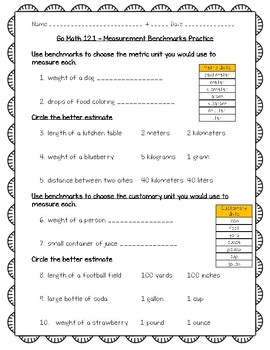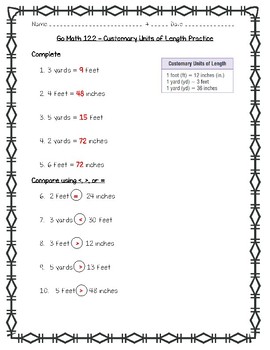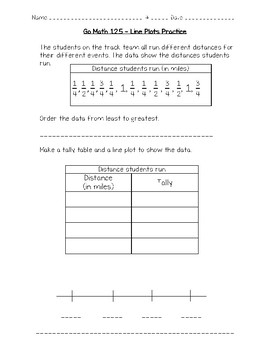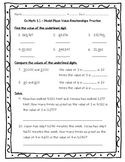Go Math Practice - 4th Grade Chapter 12 - Relative Size of Measurement Units
Joanna Riley
4.1k Followers
Grade Levels
3rd - 5th
Subjects
Resource Type
Standards
CCSS4.MD.A.1
CCSS4.MD.A.2
CCSS4.MD.B.4
Formats Included
- PDF
- Easel Activity
Pages
30 pages
Joanna Riley
4.1k Followers
Easel Activity Included
This resource includes a ready-to-use interactive activity students can complete on any device. Easel by TPT is free to use! Learn more.
What educators are saying
A great resource for students to review skills covered in class. This resource can be used as individual review or collaborative review in small groups.
This resource was a great tool that provided my students extra practice for this chapter in math. Easy to use. Just print & go.
Also included in
- What's IncludedIncluded in this pack are worksheets on all the lessons in the fourth grade Go Math series, a midchapter checkpoint practice sheet, and an end of the chapter checkpoint practice sheet for each chapter.These can be used as a quiz, formative assessment, homework, or just extra practice!Price $55.00Original Price $65.00Save $10.00
Description
What's Included
Included in this pack are 13 worksheets on all the lessons in the fourth grade Go Math book for chapter 12, a midchapter checkpoint practice sheet, and an end of the chapter checkpoint practice sheet.
These can be used as a quiz, formative assessment, homework, or just extra practice!
Answer keys are included for each worksheet.
Lesson 1: Measurement Benchmarks
Lesson 2: Customary Units of Length
Lesson 3: Customary Units of Weight
Lesson 4: Customary Units of Liquid Volume
Lesson 5: Line Plots
Mid-Chapter Checkpoint (lessons 1-5)
Lesson 6: Investigate • Metric Units of Length
Lesson 7: Metric Units of Mass and Liquid Volume
Lesson 8: Units of Time
Lesson 9: Problem Solving • Elapsed Time
Lesson 10: Mixed Measures
Lesson 11: Algebra • Patterns in Measurement Units
End of Chapter Checkpoint (lessons 6-11)
4.MD.A.1, 4.MD.A.2, 4.MD.B4
Sample 12.1 with this freebie
Chapter 1 - Place Value, Addition, and Subtraction
Chapter 2 - Multiply by 1-Digit Numbers
Chapter 3 -
Multiply by 2-Digit Numbers
Chapter 4 - Divide by 1-Digit Numbers
Chapter 5 - Factors, Multiples, and Patterns
Chapter 6 - Fraction Equivalence and Comparison
Chapter 7 - Add and Subtract Fractions
Chapter 8 - Multiply Fractions by Whole Numbers
Chapter 9 - Relate Fractions and Decimals
Chapter 10 - Compare Fractions
Chapter 11 - Angles
Chapter 12 - Relative Size of Measurement Units
Chapter 13 - Perimeter and Area
Included in this pack are 13 worksheets on all the lessons in the fourth grade Go Math book for chapter 12, a midchapter checkpoint practice sheet, and an end of the chapter checkpoint practice sheet.
These can be used as a quiz, formative assessment, homework, or just extra practice!
Answer keys are included for each worksheet.
Lesson 1: Measurement Benchmarks
Lesson 2: Customary Units of Length
Lesson 3: Customary Units of Weight
Lesson 4: Customary Units of Liquid Volume
Lesson 5: Line Plots
Mid-Chapter Checkpoint (lessons 1-5)
Lesson 6: Investigate • Metric Units of Length
Lesson 7: Metric Units of Mass and Liquid Volume
Lesson 8: Units of Time
Lesson 9: Problem Solving • Elapsed Time
Lesson 10: Mixed Measures
Lesson 11: Algebra • Patterns in Measurement Units
End of Chapter Checkpoint (lessons 6-11)
4.MD.A.1, 4.MD.A.2, 4.MD.B4
Sample 12.1 with this freebie
Chapter 1 - Place Value, Addition, and Subtraction
Chapter 2 - Multiply by 1-Digit Numbers
Chapter 3 -
Multiply by 2-Digit Numbers
Chapter 4 - Divide by 1-Digit Numbers
Chapter 5 - Factors, Multiples, and Patterns
Chapter 6 - Fraction Equivalence and Comparison
Chapter 7 - Add and Subtract Fractions
Chapter 8 - Multiply Fractions by Whole Numbers
Chapter 9 - Relate Fractions and Decimals
Chapter 10 - Compare Fractions
Chapter 11 - Angles
Chapter 12 - Relative Size of Measurement Units
Chapter 13 - Perimeter and Area
Total Pages
30 pages
Answer Key
Included
Teaching Duration
N/A
Report this resource to TPT
Reported resources will be reviewed by our team. Report this resource to let us know if this resource violates TPT’s content guidelines.
Standards
to see state-specific standards (only available in the US).
CCSS4.MD.A.1
Know relative sizes of measurement units within one system of units including km, m, cm; kg, g; lb, oz.; l, ml; hr, min, sec. Within a single system of measurement, express measurements in a larger unit in terms of a smaller unit. Record measurement equivalents in a two-column table. For example, know that 1 ft is 12 times as long as 1 in. Express the length of a 4 ft snake as 48 in. Generate a conversion table for feet and inches listing the number pairs (1, 12), (2, 24), (3, 36),...
CCSS4.MD.A.2
Use the four operations to solve word problems involving distances, intervals of time, liquid volumes, masses of objects, and money, including problems involving simple fractions or decimals, and problems that require expressing measurements given in a larger unit in terms of a smaller unit. Represent measurement quantities using diagrams such as number line diagrams that feature a measurement scale.
CCSS4.MD.B.4
Make a line plot to display a data set of measurements in fractions of a unit (1/2, 1/4, 1/8). Solve problems involving addition and subtraction of fractions by using information presented in line plots. For example, from a line plot find and interpret the difference in length between the longest and shortest specimens in an insect collection.








